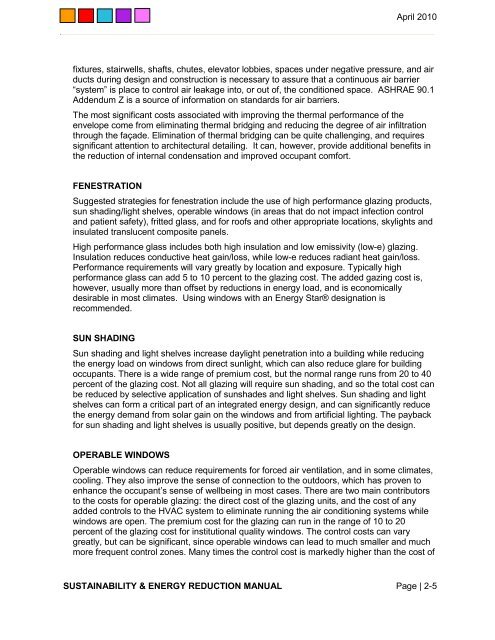Sustainability Design and Energy Reduction Manual - The Whole ...
Sustainability Design and Energy Reduction Manual - The Whole ...
Sustainability Design and Energy Reduction Manual - The Whole ...
You also want an ePaper? Increase the reach of your titles
YUMPU automatically turns print PDFs into web optimized ePapers that Google loves.
April 2010<br />
fixtures, stairwells, shafts, chutes, elevator lobbies, spaces under negative pressure, <strong>and</strong> air<br />
ducts during design <strong>and</strong> construction is necessary to assure that a continuous air barrier<br />
“system” is place to control air leakage into, or out of, the conditioned space. ASHRAE 90.1<br />
Addendum Z is a source of information on st<strong>and</strong>ards for air barriers.<br />
<strong>The</strong> most significant costs associated with improving the thermal performance of the<br />
envelope come from eliminating thermal bridging <strong>and</strong> reducing the degree of air infiltration<br />
through the façade. Elimination of thermal bridging can be quite challenging, <strong>and</strong> requires<br />
significant attention to architectural detailing. It can, however, provide additional benefits in<br />
the reduction of internal condensation <strong>and</strong> improved occupant comfort.<br />
FENESTRATION<br />
Suggested strategies for fenestration include the use of high performance glazing products,<br />
sun shading/light shelves, operable windows (in areas that do not impact infection control<br />
<strong>and</strong> patient safety), fritted glass, <strong>and</strong> for roofs <strong>and</strong> other appropriate locations, skylights <strong>and</strong><br />
insulated translucent composite panels.<br />
High performance glass includes both high insulation <strong>and</strong> low emissivity (low-e) glazing.<br />
Insulation reduces conductive heat gain/loss, while low-e reduces radiant heat gain/loss.<br />
Performance requirements will vary greatly by location <strong>and</strong> exposure. Typically high<br />
performance glass can add 5 to 10 percent to the glazing cost. <strong>The</strong> added gazing cost is,<br />
however, usually more than offset by reductions in energy load, <strong>and</strong> is economically<br />
desirable in most climates. Using windows with an <strong>Energy</strong> Star® designation is<br />
recommended.<br />
SUN SHADING<br />
Sun shading <strong>and</strong> light shelves increase daylight penetration into a building while reducing<br />
the energy load on windows from direct sunlight, which can also reduce glare for building<br />
occupants. <strong>The</strong>re is a wide range of premium cost, but the normal range runs from 20 to 40<br />
percent of the glazing cost. Not all glazing will require sun shading, <strong>and</strong> so the total cost can<br />
be reduced by selective application of sunshades <strong>and</strong> light shelves. Sun shading <strong>and</strong> light<br />
shelves can form a critical part of an integrated energy design, <strong>and</strong> can significantly reduce<br />
the energy dem<strong>and</strong> from solar gain on the windows <strong>and</strong> from artificial lighting. <strong>The</strong> payback<br />
for sun shading <strong>and</strong> light shelves is usually positive, but depends greatly on the design.<br />
OPERABLE WINDOWS<br />
Operable windows can reduce requirements for forced air ventilation, <strong>and</strong> in some climates,<br />
cooling. <strong>The</strong>y also improve the sense of connection to the outdoors, which has proven to<br />
enhance the occupant’s sense of wellbeing in most cases. <strong>The</strong>re are two main contributors<br />
to the costs for operable glazing: the direct cost of the glazing units, <strong>and</strong> the cost of any<br />
added controls to the HVAC system to eliminate running the air conditioning systems while<br />
windows are open. <strong>The</strong> premium cost for the glazing can run in the range of 10 to 20<br />
percent of the glazing cost for institutional quality windows. <strong>The</strong> control costs can vary<br />
greatly, but can be significant, since operable windows can lead to much smaller <strong>and</strong> much<br />
more frequent control zones. Many times the control cost is markedly higher than the cost of<br />
SUSTAINABILITY & ENERGY REDUCTION MANUAL Page | 2-5

















